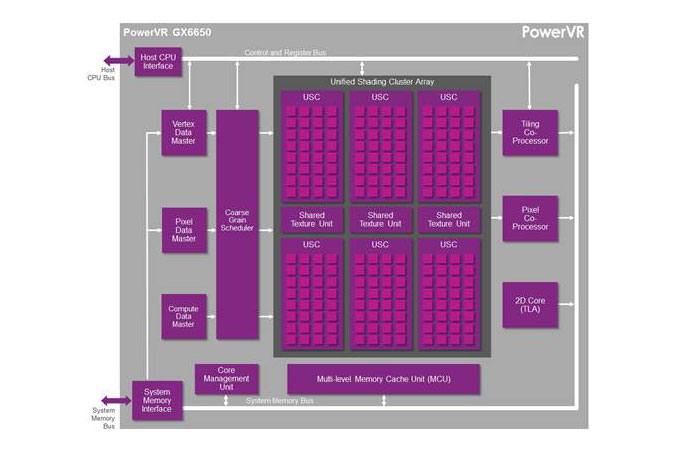Imagination's PowerVR GX6650: Competition for Mobile Kepler
by Anand Lal Shimpi on February 24, 2014 3:27 AM EST
Ryan touched on this in his excellent deep dive on Imagination's PowerVR Series 6XT GPU architecture earlier today, but I wanted to specifically call out the new high-end from IMG that was announced back in January. Pictured above is a high-level block diagram of the new PowerVR GX6650, this is IMG's answer to NVIDIA's mobile Kepler/Tegra K1.
Below I've included a modified version of Ryan's comparison table from his architecture piece:
| GPU Specification Comparison | |||||||
| NVIDIA K1 | Imagination PowerVR GX6650 | Imagination PowerVR G6430 | Imagination PowerVR G6230 | ||||
| FP32 ALUs | 192 | 192 | 128 | 64 | |||
| FP32 FLOPs | 384 | 384 | 256 | 128 | |||
| Pixels/Clock (ROPs) | 4 | 12 | 8 | 4 | |||
| Texels/Clock | 8 | 12 | 8 | 4 | |||
| GFLOPS @ 300MHz | 115.2 GFLOPS | 115.2 GFLOPS | 76.8 GFLOPS | 38.4 GFLOPS | |||
| Architecture | Kepler | Rogue (Series 6XT) | Rogue (Series 6) | Rogue (Series 6) | |||
I tossed in the Series 6 PowerVR G6430 as a comparison point. The G6430 is the GPU in the iPad Air/iPad mini with Retina Display/iPhone 5s. If Apple decides to go all out with a GPU upgrade on its next-generation iPad Air (A8/A8X silicon perhaps?), the GX6650 would likely be the IP to use.










16 Comments
View All Comments
ltcommanderdata - Monday, February 24, 2014 - link
Up to now Apple seems to like to stick with a GPU architecture for 2 generations of SoC (such as Series 5 SGX535 in the 3GS and A4 devices and Series 5XT SGX543MP in the A5/A5X and A6/A6X devices) which no doubt simplifies design and driver development. I wouldn't be surprised if the A8 moves to a higher clock speed G6630 from the G6430 in the A7 similar to the transition to a higher clock speed SGX543MP3 in the A6 vs the SGX543MP2 in the A5.dragonsqrrl - Monday, February 24, 2014 - link
This will probably be the case since the 6XT series won't come to market before 2015, according to an earlier article published here on Anandtech.iwod - Monday, February 24, 2014 - link
Yes I would have thought of that as well. Until Apple did their A7 SoC which actually shocked everyone in the world apart from themselves. Their 64bit ARM SoC came WAY earlier that anyone expected including ARM. So it may not be much of a surprise if Apple pull the same trick again for 6XT.dragonsqrrl - Wednesday, February 26, 2014 - link
Apple doesn't develop their GPU's... Apple developed their 64-bit ARM architecture... it's two completely different things. Apple wasn't first to market with 64-bit because they were on some sort of greatly accelerated development schedule compared to other chipmakers. Apple was first because they started development first, and made investments in 64-bit before anyone else.We know when the 6XT series became available for licensing and integration, and at this point it would be nearly impossible for Apple to use a 6XT derivative in the A8 if they keep to their regular release schedule. The A8 is probably nearing production at this point.
easp - Tuesday, February 25, 2014 - link
Patterns of past behavior can be useful in predicting the future, but I think the best thing to take away from Apple's past behavior is that they are going to do what they can do, and need to do, to deliver great products with great user experiences.If that means a more aggressive ramp in GPU, then they will find a way to do it. Choices that would have been impossible in the past may be practical now since they keep adding design/engineering capability, and have more and more volume to work with, particularly if they continue using the same die for both iPad and iPhone.
fteoath64 - Tuesday, February 25, 2014 - link
The key to this comparison is really the power consumption for the same performance metric. The one with lower gpu_ops/watt wins. It is about efficiency. Both vendors have challenges in this area main due to process node and design factors. K1 claims it can do max-throttle at 2 watts while it looks like the Rogue 6430 (in iPhone and ipad) was straining at about 5 to 6 w in Anand's test.Let us say 5w but it is only 2/3 the power of 6650. This means the 6650 will pull 7.5w alone at full throttle!. They will have to throttle down the frequency a lot to bring it under 4 watts.
I say K1 will win with better battery performance compared to PVR 6650. So NV's claim of 1.5X power efficiency might have some merit. We shall see but it is interesting to see head-to-head competition as the result would be a way better product from either side. Each can optimise for whatever their design excels.
Note: One can bet that NV must have done a lot of super-computer simulations of their target designs to choose the number of functional units they had in their gpu. They had the Tesla super on tap for such things. Other, would not likely have such access.